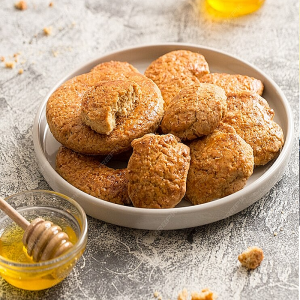Sweet Honey Cakes – Ancient Egypt (Athenaeus of Naucratis) Placentae mellitae – Aegyptus Antiqua (Athenaeus Naucratita)
 Garanties sécurité
Garanties sécurité
(à modifier dans le module "Réassurance")
 Politique de livraison
Politique de livraison
(à modifier dans le module "Réassurance")
 Politique retours
Politique retours
(à modifier dans le module "Réassurance")
𓎃𓇋𓆤 Sweet Honey Cakes – Ancient Egypt (Athenaeus of Naucratis) Placentae mellitae – Aegyptus Antiqua (Athenaeus Naucratita)
Athenaeus of Naucratis, in his work The Banquet of the Sophists, compiled various anecdotes and descriptions of ancient cuisine. Although he did not always provide detailed recipes, he mentioned sweet cakes and legume-based dishes. Here is a reconstruction inspired by descriptions of dishes mentioned in his writings.
1. Sweet Honey Cakes 𓎃𓇋𓆤
These cakes were popular in the Greco-Roman Egyptian region.
Ingredients:
- 200 g of spelt or wheat flour (▷ ʞıℴ to represent "flour")
- 100 ml of lukewarm water
- 2 tablespoons sesame or olive oil (ʞʟ symbolizes oil in hieroglyphs)
- 3 tablespoons raw honey (△ symbolizes ancient beehives)
- A pinch of salt
- Optional: sesame seeds for garnish
Preparation:
- Dough Preparation: In a bowl, mix the flour, lukewarm water, oil, salt, and 1 tablespoon of honey. Knead until the dough is smooth and pliable.
- Resting: Let the dough rest for 30 minutes under a damp cloth.
- Forming the Cakes: Divide the dough into small balls and flatten them to form cakes about 1 cm thick.
- Cooking: Cook the cakes in a hot, dry skillet for 3 to 5 minutes on each side until golden.
- Finishing Touch: Brush the warm cakes with the remaining honey and optionally sprinkle with sesame seeds.
2. Herb-Infused Legume Stew with Honey
This typical dish mentioned by Athenaeus highlights the simplicity and richness of legumes.
Ingredients:
- 200 g chickpeas (soaked for 12 hours)
- 1 sliced onion
- 2 crushed garlic cloves
- 2 tablespoons sesame or flaxseed oil
- 1 tablespoon honey
- 1 tablespoon chopped fresh coriander
- 1 tablespoon chopped dill
- Salt and pepper
- Lemon juice or date vinegar (Date vinegar is known for its sweet, mild, and slightly tangy flavor. It offers a delicate balance between the natural sweetness of dates and the characteristic acidity of vinegar, with rich notes of caramel, plum, and honey.)
Preparation:
- Chickpea Cooking: Cook the chickpeas in salted water until tender (about 1 hour). Drain.
- Base Preparation: Heat the oil in a pan and sauté the onion and garlic until golden.
- Assembly: Add the cooked chickpeas to the pan. Stir in the honey, fresh herbs, salt, and pepper. Mix gently.
- Final Cooking: Simmer over low heat for 10 minutes to allow the flavors to develop. Optionally, drizzle with lemon juice or date vinegar before serving.
Historical Context:
These two recipes illustrate simple yet flavorful dishes, in harmony with the culinary traditions evoked by Athenaeus of Naucratis and the dietary practices of ancient Egypt. The honey-based sweet cakes were a common treat consumed during festive or religious meals. As for legumes, they were a staple in many dishes, representing an essential source of protein in the ancient diet.


